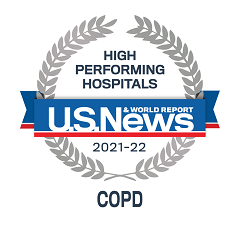 In June 2019, Cooper University Health Care became the first hospital in New Jersey to offer bronchoscopic lung volume reduction for severe emphysema and COPD (chronic obstructive pulmonary disease).
In June 2019, Cooper University Health Care became the first hospital in New Jersey to offer bronchoscopic lung volume reduction for severe emphysema and COPD (chronic obstructive pulmonary disease).
What is bronchoscopic lung volume reduction?
Patients with severe emphysema and COPD commonly experience hyperinflation of the lungs, which happens when they are not able to fully exhale before starting to inhale, causing air to get trapped in the lungs. As the lungs continue to inflate due to trapped air, the lungs do not work properly, making it difficult to breathe. Bronchoscopic lung volume reduction is a procedure used to reduce hyperinflation, helping patients breathe easier, improving their quality of life.
Bronchoscopic lung volume reduction is performed by an interventional pulmonologist and involves a minimally invasive (nonsurgical) 30-minute to 60-minute procedure. During this procedure, the physician uses a bronchoscope, a flexible, narrow tube that is guided through the mouth or nose and down into the lungs, to implant tiny devices called endobronchial valves. These valves block off the diseased parts of the lungs and allow the healthy areas of the lungs to function more efficiently.
Patients are asleep for the procedure and do not feel any discomfort. Typically, this procedure requires a multi-night stay in the hospital for observation and additional testing as needed.
Who is a candidate for bronchoscopic lung volume reduction?
During a patient’s initial assessment, a Cooper interventional pulmonologist will do a physical examination and order lung function tests to determine if the patient is a good candidate.
A patient may be a candidate for bronchoscopic lung volume reduction if he/she:
- Is able to have a bronchoscopic procedure
- Does not have an active lung infection
- Does not have an allergy to nitinol, nickel, titanium, or silicone
- Does not smoke
- Does not have large bullae (air pockets) encompassing greater than 30% of either lung
Other health conditions that may affect a patient’s ability to have bronchoscopic lung volume
reduction:
- Lung transplant, lung volume reduction surgery, or any other major lung procedure
- Heart disease or recent heart attack
- Clagett window or Eloesser flap
Schedule an Appointment
To learn more about bronchoscopic lung volume reduction or to schedule a consultation, call 856.342.2406.
